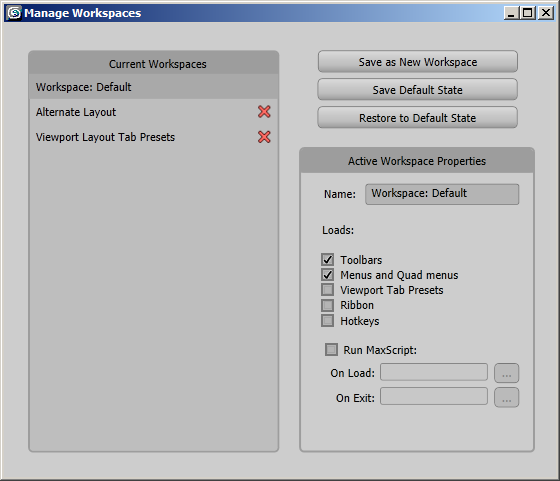Interface: WorkspaceManager
The WorkspaceManager Core Interface exposes the features of the Manage Workspaces dialog to MAXScript.
Available in 3ds Max 2013 and higher.

Methods:
<boolean>WorkspaceManager.CreateNewWorkspace <string>identifier <string>friendlyNameCreates a new Workspace with identifier string specified by the first argument and a user-friendly name specified by the second argument.
Returns True on success, False on failure.
<integer>WorkspaceManager.GetWorkspaceCount()Returns the number of Workspaces.
<string>WorkspaceManager.GetWorkspaceIdentifier <index>indexReturns the Identifier of the indexed Workspace.
The index is 1-based.
<string>WorkspaceManager.GetWorkspaceName <index>indexReturns the User-friendly Name of the indexed Workspace.
The index is 1-based.
<string>WorkspaceManager.GetWorkspaceNameWithIdentifier <string>identifierReturns the User-friendly Name of the Workspace with the given identifier string.
<string>WorkspaceManager.GetCurrentWorkspaceIdentifier()Returns the identified or the current Workspace.
<boolean>WorkspaceManager.SetCurrentWorkspaceByIdentifier <string>identifierSets the current Workspace to the one with the given identifier string.
Returns True on of the Workspace was set successfully, False if the identifier does not exist.
<boolean>WorkspaceManager.DeleteWorkspace <string>identifierDeletes the Workspace with the given identifier.
Returns True if the Workspace was deleted successfully, False if the identifier does not exist.
<string>WorkspaceManager.GetWriteDirectory()Returns the Workspace storage path.
<boolean>WorkspaceManager.SetWorkspaceName <index>index <string>nameSets the name of the indexed Workspace to the name specified by the second argument.
The index is 1-based.
Returns True on success, False on failure.
<boolean>WorkspaceManager.SetWorkspaceNameWithIdentifier <string>identifier <string>nameSets the identifier string of the indexed Workspace to the name specified by the second argument.
Returns True on success, False on failure.
<boolean>WorkspaceManager.ResetToDefaults <string>identifierResets the Workspace with the specified identifier string to defaults.
Returns True on success, False if the Workspace does not exist.
EXAMPLE
format "Workspaces Directory: %\n" (WorkspaceManager.GetWriteDirectory()) theCount = WorkspaceManager.GetWorkspaceCount() --get the number of workspaces for i = 1 to theCount do --loop through them (one-based!) and print them all ( theID = WorkspaceManager.GetWorkspaceIdentifier i --get the identifier theName = WorkspaceManager.GetWorkspaceName i --get the user-friendly name format "%: ID:'%' Name:'%' \n" i theID theName --print the index, the identifier string and the name ) currentID = WorkspaceManager.GetCurrentWorkspaceIdentifier() --get the current workspace's indentifier currentName = WorkspaceManager.GetWorkspaceNameWithIdentifier currentID --get the current name WorkspaceManager.CreateNewWorkspace "justtesting" "Testing" --create a new workspace WorkspaceManager.SetCurrentWorkspaceByIdentifier "justtesting" --make the new workspace current WorkspaceManager.SetCurrentWorkspaceByIdentifier currentID --set the previous workspace as current WorkspaceManager.SetWorkspaceName (theCount+1) "ToDelete" --rename the new workspace by index WorkspaceManager.SetWorkspaceNameWithIdentifier "justtesting" "NoReally" --rename the new workspace by identifier WorkspaceManager.DeleteWorkspace "justtesting" --delete the new workspace by identifierLISTENER OUTPUT
Workspaces Directory: C:\Users\YourName\AppData\Local\Autodesk\3dsMax\2013 - 64bit\ENU\en-US\UI\Workspaces 2 1: ID:'alternate' Name:'Alternate' 2: ID:'standard' Name:'Standard' "standard" "Standard" true true true true true true
<boolean>WorkspaceManager.GetRunScript <string>identifierReturns the state of the Run Script option for the Workspace with the given identifier.
When it is True, the Entry and Exit Scripts associated with the Workspace will be executed.
When set to False, the scripts will be ignored.
<void>WorkspaceManager.ToggleRunScript <string>identifierToggles the Run Script option of the Workspace with the given identifier.
This can be used together with WorkspaceManager.GetRunScript to change the state of the option.
For example, to turn the option on, you can check if it is currently set to False and toggle it if it is.
EXAMPLE
theWS = WorkspaceManager.GetWorkspaceIdentifier 1 if not (WorkspaceManager.GetRunScript theWS) do WorkspaceManager.ToggleRunScript theWS
<filename>WorkspaceManager.GetEntryScript <string>identifierReturns the filename of the Entry Script associated with the Workspace with the given identifier.
The Entry Script is a MAXScript which is executed when the Workspace is loading.
<boolean>WorkspaceManager.SetEntryScript <string>identifier <filename>scriptAssociates the Entry Script filename specified by the second argument with the Workspace given by the identifier passed as first argument.
Returns True on success, False if the identifier does not represent an existing Workspace.
Note that this method does not check whether the specified script is valid or even exists at the specified path.
<filename>WorkspaceManager.GetExitScript <string>identifierReturns the filename of the Exit Script associated with the Workspace with the given identifier.
The Exit Script is a MAXScript that is executed when the Workspace is exiting due to another Workspace being loaded.
<boolean>WorkspaceManager.SetExitScript <string>identifier <filename>scriptAssociates the Exit Script filename specified by the second argument with the Workspace given by the identifier passed as first argument.
Returns True on success, False if the identifier does not represent an existing Workspace.
Note that this method does not check whether the specified script is valid or even exists at the specified path.
<integer>WorkspaceManager.GetAllSubsystemsCount()Returns the number of all sub-systems.
<string>WorkspaceManager.GetSubsystemName <index>indexReturns the name of the indexed sub-system.
<boolean>WorkspaceManager.IsSubsystemSaving <string>identifier <string>subSystemIdentifierReturns True if the sub-system specified by name by the first argument will be saved when the Workspace with the identifier given by the second argument is saving, False otherwise.
<boolean>WorkspaceManager.ToggleSubsystemSaving <string>identifier <string>subSystemIdentifierToggles whether the indexed sub-system specified by the first argument will be saved when the Workspace with the identifier given by the second argument is saving.
Returns the new saving state.
<boolean>WorkspaceManager.IsSystemWorkspace <string>identifierReturns True if the Workspace specified by the given identifier is a system workspace, False if it is not.
EXAMPLE
for w = 1 to WorkspaceManager.GetWorkspaceCount() do ( theWS = WorkspaceManager.GetWorkspaceIdentifier w theWSName = WorkspaceManager.GetWorkspaceName w isSystem = WorkspaceManager.IsSystemWorkspace theWS format "\n%:% Workspace ID: % | Name:\"%\"\n" w (if isSystem then "SYSTEM" else "Custom") theWS theWSName for i = 1 to WorkspaceManager.GetAllSubsystemsCount() do ( theName = (WorkspaceManager.GetSubsystemName i) isSaving = (WorkspaceManager.IsSubsystemSaving theName theWS) format "\t%: % | isSaving:%\n" i theName isSaving ) )SAMPLE OUTPUT
1:SYSTEM Workspace ID: Workspace1 | Name:"Workspace: Default" 1: kMeta | isSaving:false 2: kCui | isSaving:true 3: kViewportPresets | isSaving:false 4: kMenu | isSaving:true 5: kHotkeys | isSaving:false 6: kRibbon | isSaving:false 2:Custom Workspace ID: Workspace2 | Name:"Alternate Layout" 1: kMeta | isSaving:false 2: kCui | isSaving:true 3: kViewportPresets | isSaving:false 4: kMenu | isSaving:true 5: kHotkeys | isSaving:false 6: kRibbon | isSaving:false 3:Custom Workspace ID: Workspace3 | Name:"Viewport Layout Tab Presets" 1: kMeta | isSaving:false 2: kCui | isSaving:true 3: kViewportPresets | isSaving:false 4: kMenu | isSaving:true 5: kHotkeys | isSaving:false 6: kRibbon | isSaving:false OK
